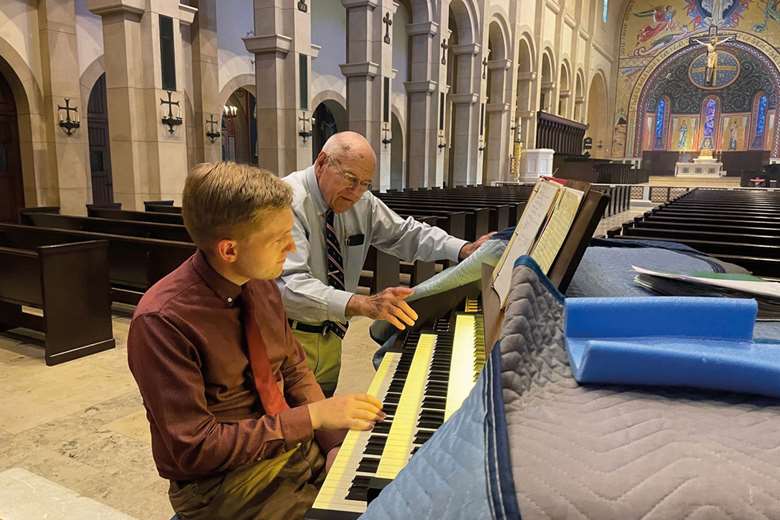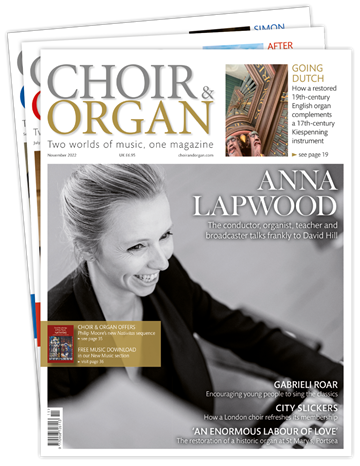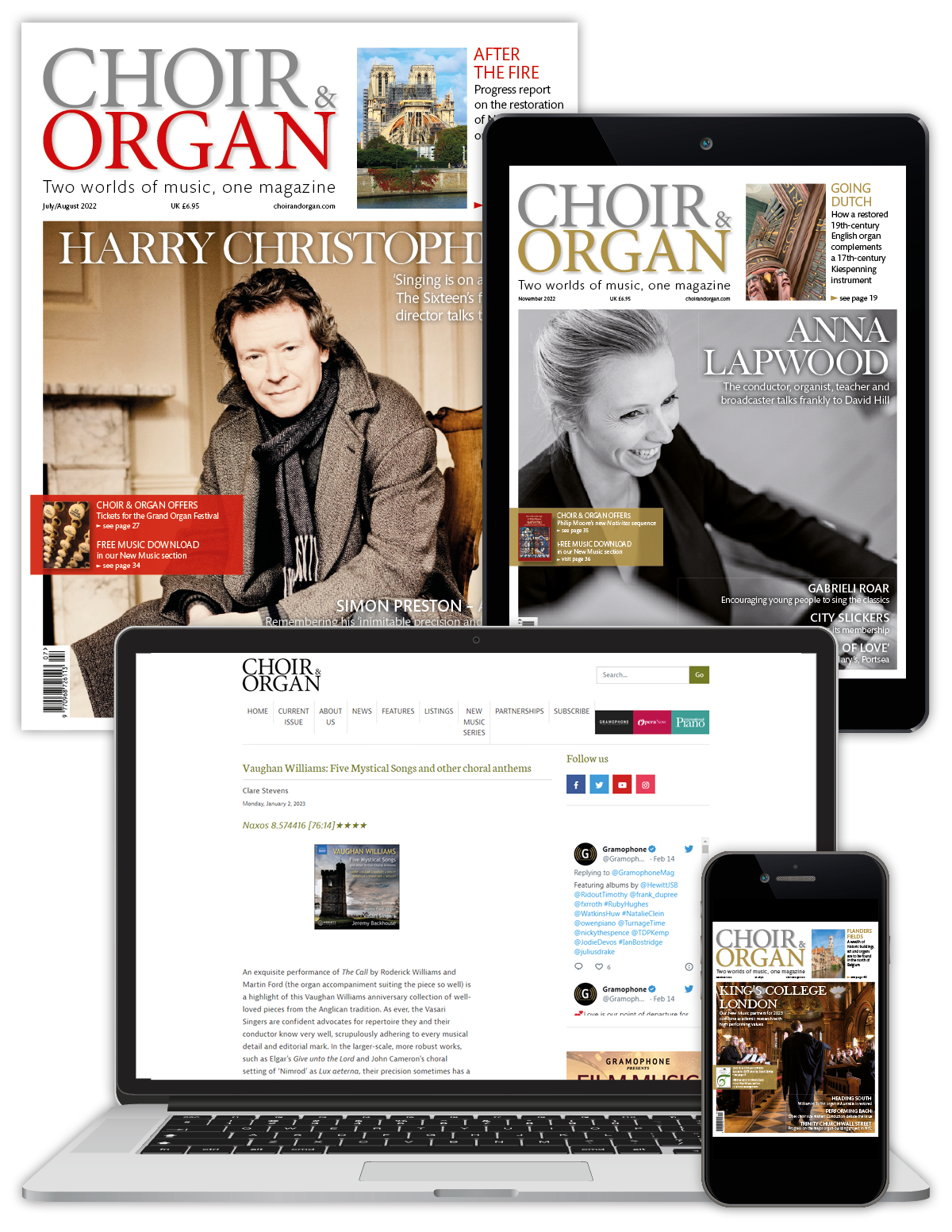Bryan Dunnewald: meeting the newly named president of Schoenstein & Co
Jonathan Ambrosino
Friday, November 8, 2024
Bryan Dunnewald, newly named president and tonal director of California organ builder Schoenstein & Co, has emerged as one of the most prodigious young people on the US organ scene. He talks to Jonathan Ambrosino. Photos courtesy of the organ builder.

Through his schooling – Interlochen Academy, Mannes School, Curtis Institute – Bryan Dunnewald placed equal emphasis on playing, composing and conducting, the latter both choral and orchestral. But all along he was drawn to the organ’s technical side, which led to summers at Schoenstein, in Benecia, California, for a kind of fast-track apprenticeship. For some, this might have quenched the thirst for good, but for Dunnewald the experience only solidified an intent to focus his career in that direction.
This precociousness seems built into the man. Dunnewald grew up in Denver, where the organ bug bit early. ‘Through elementary and middle school,’ he recalls, ‘my grandmother would drive me across the state to play organs. We found a warm welcome everywhere.’ By the age of 12, he had already played about 90 instruments. ‘This taught me to appreciate the best in every organ, no matter its size or style. It showed me that stop lists and names mean nothing until you hear them. And it also demonstrated how to find an instrument’s personality.’

Working out scales for Op 185, Church of the Good Shepherd, Corpus Christi, Texas
Denver-area organs were formative. ‘The first I heard and played regularly was the four-manual 1888 Roosevelt at my boyhood church, Trinity Methodist in Denver. I always liked this organ, but my appreciation increased substantially later on. It can easily build to a roar and lead a full (1,000-plus seat) house, but its real magic is in its chamber music and accompanying abilities. It uses its size to add more piano and mezzo voices instead of redundant loud ones.’ Another formative instrument was the 1938 Kimball at St John’s Episcopal Cathedral, restored in 2012. ‘This may be my favourite organ. The combination of warm tone – singing diapasons, reeds with depth, loads of colour – and rock-solid ensembles still inspire me.’ Third on his list is the 1937 Aeolian-Skinner at St Mark’s in Philadelphia, an early and unusually complete American Classic organ of G Donald Harrison. Dunnewald came to know it well as assistant organist and choirmaster there from 2015 to 2022. ‘Of the organs I’ve played, I know it best, having spent six years playing it almost daily. My favourite things are its beautiful, varied and never-redundant choruses; colour not through exotic stops but subtle and sophisticated basics; and an additive quality that prevents this very large organ from ever feeling over-the-top.’
This Anglo-Catholic parish was another formation experience for Dunnewald, where he helped maintain parish music through the Covid-19 pandemic, and assisted with the parish’s comparatively recent embrace of chorister training. As in most Oxbridge positions, Dunnewald absorbed much on the job. ‘I learned how to accompany, lead hymns, conduct – all at a high level. This experience drove home the importance of a useful organ: how an instrument’s basic ingredients best support a demanding programme.’ Other conducting was not only useful in itself, but offered insights into organ building. ‘At Curtis, Mannes, and other places like the Buffalo Philharmonic, where I was a conducting fellow, I absorbed the sound of the orchestra, its colour and balance, which always made me think again about organ sounds and how they interact.’
The first Schoenstein that Dunnewald encountered was at the Conference Center of the Church of Latter-Day Saints in Salt Lake City, a 130-rank five-manual completed in 2003. ‘I was blown away by its size and timbral variety, and at 11 years old I didn’t much know how to handle it. Luckily, Tabernacle organist Rick Elliott showed me what it can do.’ The first Schoenstein Dunnewald felt he truly understood was the firm’s ground-breaking 1996 opus for St Paul’s K Street in Washington DC, in which classical choruses merge with neo-symphonic tonalities and mechanism (double expression, variable tremulants). ‘That sound, especially when mixed with the phenomenal choral singing and rousing hymn playing, sticks with me still. The super-talented organists there were set completely free and allowed to make music.’
These experiences led Dunnewald to his summers at Schoenstein. ‘Even as a nine-year-old, I had wanted to explore the organ’s inner workings and loved its complex mechanical systems,’ he recalled. ‘I first visited Schoenstein and met [then-president and tonal director] Jack Bethards on a high school organ recital tour to San Francisco. This wasn’t my first visit to an organ factory, but I was immediately drawn to this particular shop and Jack’s approach. From that visit forward, we kept in touch, to the extent that Jack ended up serving as a mentor throughout my schooling and into my professional life.’

Schoenstein Op 185, Church of the Good Shepherd, Corpus Christi, Texas
Like old-time pen pals, the two would work on tonal projects from afar – ‘detailed proposals and design ideas for new organs in venues that didn’t know they needed them! We also exchanged thoughts on many other topics: favourite composers and orchestrators, business leadership, and organ-building history.’ In hindsight, the value of his summers becomes clearer. ‘I understand more of what it takes for the person at the bench to build the organ. It also taught me how inter-connected each component is to the final result.’ In 2022 Dunnewald left Philadelphia for Schoenstein, and in rapid succession rose to tonal director in August 2023 and, this past July, president.
It’s a weighty role for a man of 29. (To give context, G Donald Harrison was 44 when he took technical control of Aeolian-Skinner in 1933; Lawrence Phelps was 45 when he did likewise at Casavant in 1958.) While changes in leadership often bring shifts in tonal philosophy, continuity seems the thrust here. ‘What attracted me most to Schoenstein was Jack’s tonal philosophy, [combined with] his interest in constant improvement and refinement. I’m aiming to continue that culture, to progress in a smooth manner without surprises. I take a step-by-step approach to tonal exploration and continue to discuss ideas with Jack. The result is the best of both worlds, if you ask me: refinements and new ideas worked out methodically.’
I was curious for specifics. ‘Take the practice of slotting in flue pipes. The company has done extensive research on slots: their precise dimensions, how they impact the colour, where they give a stop an ability to project and blend with others. Slots are an example of “with great power comes great responsibility,” as even the smallest change in dimension produces noticeably different results.’ He sees a specific link here between organ tone and the human voice. ‘In certain instances, slotted diapason tone can more closely match a singer’s “ah” vowel, allowing that type of tone to project into a room, from even the most buried chamber.’
Schoenstein’s approach to chorus work has featured narrow, somewhat driven mixtures loosely in the Willis vein. Does that still appeal? ‘By and large yes, but I’ve also been studying the wonderful choruses at St Mark’s Philadelphia in order to apply, where appropriate, G Donald Harrison’s principles of design – mixtures in particular – to our scaling system. Simply copying his work would likely yield unsatisfactory results, like a virtuoso tenor trying to sing a mezzo-soprano solo. The more difficult task of adapting his approach to meet our musical vision is where the payoff lies.’
Dunnewald brings something rare to his position: an actual interest in business. ‘My father is a retired business executive, and I grew up discussing business and finance with him. I enjoy the business side almost as much as the musical one. When you think about it, good business leads to better sounding organs, because a sound company has the reserves, resources, and resilience to weather any challenge: investing in careful research and design, really spending the time on site to make everything just right. Variety has always been a highlight of working in the organ business and that hasn’t gone away, even as my position within the company has evolved.’
In addition to his duties at Schoenstein & Co, Dunnewald is also director of music at Lafayette-Orinda Presbyterian Church in Lafayette, California, where he conducts the volunteer and professional choirs, plays the organ, and composes and arranges music. Given his age, Bryan Dunnewald seems poised for a decades-long run at Schoenstein, one that will be intriguing to watch.
Jonathan Ambrosino is an organ technician based in Boston, Massachusetts, and a consultant to organ projects across the USA. He has written for C&O since 1998






